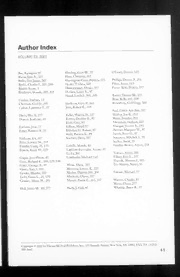
Seminars in Hearing 2002: Vol 23 Index PDF
Preview Seminars in Hearing 2002: Vol 23 Index
Author Index Copyright 2002 by 584-4662 Subject Index ilation Index), dot Deticit Hvp ADHD), 337-338 APD, 340-345 Deficit Hyperactivity isorder (ADHD lit \PD 185, 193 atory evoked potentials and MLR, : 1odality vs. hearing te ry functions, primary elements,8 4 uditory Neuropathy (AN), 183, 198-19 \uditory Neuropathy/ Auditory Dys synchrony; Cochlea, inner hair « hair cell wudibility vs. neuropathy, 188 children, infants, and newborns ige of onset and progression, 199 clinical investigations, 196-197 2002 by Thieme 4662 1-4 SEMINARS IN HEARING/VOLUME 23, NUMBER 4 2002 \uditory Processing Disorders (APD), adolescent nanagement of adults with APD and peripheral 1 and adults (continued hearing loss, 3 peripheral hearing loss, with, 332-334 olivary nuclei,2 5 specific subtypes and Attention Deficit plasticity, 253 Hyperactivity Disorder, 339-340 Central Auditory Processing (CAP), 251-256 classroom acoustics evaluation and modification, Central auditory processing disorders CAPD 309-310 252, 280, 319 management and intervention diverse temporal processing problem, 256-257 audiologist role, 281-282 five types of central auditory processing electrophysical measures, disorders, 320 321 historical overview, 279 management of developmental language delay multidisciplinary approaches, 288-294 play therapy in children, 325 treatment evaluations, 361-363 management tripod, 320-324 neurological disorder definition, 227-278 clinical examples, 324-325 Auditory Training (AT) in auditory processing ‘hannel capacity, 57-58, 66 disorders, 265-266, 298-299 cochlea implant patients, 66-67 adolescents and adults, 330 neural function loss, 72 audi1t ory discrimination, 269 Signal-to auditory evoked potentials, 267,350-3 c+ hronic auditory gain,2 5 wuditory skills, neural plasticity and ‘lassroom Reverberation | reorganization2,7 1 auditory proce formal and informal traini echniaqi 271, 300-306 Mismatch Negativity Potential (MMN), 267, ) 69, 32c5 1-352 , ' \uditory-visual ] sIp eech integration, ag changes, 95 \ural rehabilitatior assistive devices, : 4 audiolo| gy, 5 aural 1 renreahbaihilliitraatt ion ¢g ad|v anced tech| nolo, gy vs hearing lo Bal , yalance m anatomy, 108 Benign DP. aroxysmal Positiona 1 Vertigo biochemistry, calcium concentratienodnol,y m ind peripheral circulation, 14 otoconia debris, 145 otolit h system and cal1 cium carb 144 canalithiasis and cuplolithiasis, 103 mversatio clinical research, 136-138 auditory thresholds, 35 pathophysiology peech intelligibility, improved, 72 posterior semicircular canals (PSCC Cortical plasticity, mechanisms at treatment methods, therapeutic, 129-1 264-265 138-139, 154 Critical period of developmental pla video oculography (VNG), 133 Deat Pride, 9 Central Auditory Nervous System (CANS), Dizziness, patient history and diagnosis, 108-109 cochlear nerve, parallel and hierarchical processing, 252 Erber’s area, 40-41 SUBJECT INDEX 1-5 Falls in the elderly los following he iring al interventions, 170-171 N¢ uropathy, 209 risk factors and patient evaluation, 162, 164-171 oliviocochlear re statistics, morbidity and mortality, 161-162 LiiittTyy 1 \ |n eariniT t Fast ForWord, 258-259, 268, 300 transient evoked TEOAI product (DPOAE), 196 Habituation-based treatment protocol. See Tinnitus Retaining Therapy Perceptive Articulation Index, 5% Hearing aid microphone types, 78-80 acoustic il pees cue replacemer Hearing aid use and benefit, 35, 37 Permanent Threshold Shift (PTS), conversational m inagement strategies, 38-39 Plastic and adaptive auditory gain, 21 face-to-face conversation, 36, 39—40 VOR, relation hip o, 25 unaided fluency level, 39-40 Psychological behavior it Hearing In Noise Test (HINT), 60 coping difficultice Hearing disassociative bel oxidative damage, 17 mbart issment experimental research, heredity and loss arch, 3,9 protection, 15 gmatization, NMDA (N-methyl-D asparate rece ptor PTA (Pure Tone simulation and NO (nitric oxide) releas¢ L / Pure-tone thre prevention, 15-16 Hereditary hearing loss, 115-116 Hyperacusis, 23, 31. § Pinnitus Retaining Therapy hearing impairment,2 3 Loudness Discomfort Levels, 23-24 Inter-Stimulus Intervals (ISIs), 258 rinthine Storm, 150 yyrinthitis, stabilized, yuaye ACQUISITION 11 Lipreading,9 5 comfort | evel Hyperacusi 1 tolerat un proces emental shifts fron Masking Level Difte rence Auditory Neuropathy 205 Meniere’s Disease, chronic, 114, 150 Middle-and long-latency response tests, 1 188-189 Middle-ear muscle reflexes (MEMR), 201-202, : Mini-Mental Status Examination (MMSE), 165 Missing Dots. See Cochlea, inner hair cells Missing speech cues, 57-58, 66 middle ear muscl contril olivocochlear efferent sy Otoacoustic emissions (OAE) in auditory preconditioning, 13 neuropathy, 183-187, 193-199. See als hereditary hearing loss protection, 15 \uditory Neuropathy Auditory Dys low-level sound conditioning, 17 synchrony; Cochlea Microphonics paradigms, 14-16 1-6 SEMINARS IN HEARING/VOLUME 23, NUMBER 4 2002 Sound-field PM amplification sy stems neb: ulous chronic ada, ptive Auditory Processing Disorder 1 resetting, ) 24 281-282, 321-3 330 sound tolerance modification, classroom acoustics evaluation and 313,314 patient fitting, training and tre atme 313-316 Vertigo personal EM system fo1 Audit ry P)r ocessing nonvestibu Disorders, indicators and | 108 310-313 sripher Sound i tolerance modit - symptoms, 109 expansion, 22 ) Speech, frequency range of s} Speech In Noise SIN , 58 \uditory Neuropathy aA udi5 tor y Dvs 206 \uditory Proces directiona hearing a und Signal to word ] recog Speech Intelligib opeech1- perceptior pertorn
